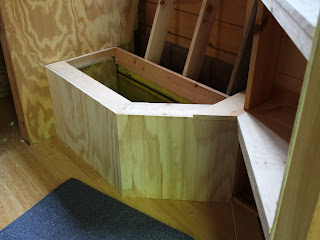Bis Appellare-
Draco, Draco!
-Tanith Lee
So, for a long time now I've been trying to come up with a better solution to the 'How do we hide the ugly trailer hitch' problem. In years previous, I've used a sort of plastic mesh that has fake ivy leaves to cover it. I've used the same stuff on the leveling jacks.
You can see it in this picture. Frankly, I don't think we were fooling anyone. That is, I doubt anyone thought that an ivy bush had suddenly decided to grow in the middle of a field:
Not terrible, but not great, either. I've never really been happy with that solution, and I decided to re-work all the camouflaging for the vardo, starting with the hitch cover.
Originally, I'd thought about using chicken wire and void filler to make a hollow 'rock' to fit over it, but that would be really hard to stow for travel. We already have enough bulky and awkward items to pack for Pennsic, I wanted something that would be easy to manage, and not too heavy.
So round the time we dropped the vardo off with Lars, Norm and I went out to dinner at a local place with my son Ian. Ian's 18 and just graduated high school, and likes to draw and play music. He's been very enthusiastic over the whole project, even though he doesn't get to live in the vardo. (He has a very nice Viking A-frame instead.)
So, over a carafe of sangria (and a glass of soda), we all started talking about the hitch cover problem. Should we do it out of plywood? What should the design be?
Ian: How about a viking dragon? Like on a ship's prow?
(I should note that his dad being of direct Norwegian ancestry, Ian is a perfect example of your typical giant-adolescent-Viking)
Me: A dragon would be cool, but I want the vardo to have a celestial theme. I don't think that would 'go'.
Ian: Well, what if it was a STAR dragon?
Me: You mean, like a constellation?
Ian: Yeah! You could have it be a dragon and a constellation at the same time.
Norm: Isn't there actually a dragon constellation?
Me: Yeah, I think there IS!
We all started shooting suggestions back and forth, and I sketched them all out on my place mat:
So,to begin with, I needed to figure out the general shape of the area that needed to be covered. I didn't want to do a whole lot of work on something only to find out it was too small. So I used a piece of cardboard to estimate the minimum coverage:
Next, I used that as a template to base the dragon design on. As long as I 'enclosed' all of the 'test' piece in the design, the entire hitch would be covered. Here's the finalized drawing on cardboard, which I then cut out with a box cutter.
A quick test to see if it would fit, look OK, etc. Unfortunately, I neglected to test whether the door would open, so later on in the process Draco had to lose about 1 inch of his 'crest'.
As I mentioned earlier, a second test revealed that Draco's 'crest' extended too far back and interfered with the door opening. So, we gave him a bit of a haircut. Next, Norm screwed a 1x2 framework onto the back of each one to reinforce it. I filled in all the screw holes with wood filler, and then sanded it all smooth. Finally, each piece got 2 coats of flat black enamel on all sides.
Here they are with the original cardboard template. I cut out the mouth and eyes and the 'crest' area, to use it as a template for the artwork. I traced the template on each with a white pencil.
So here they are placed on the vardo to see how they will look when they're doing 'guard duty'. I'm very pleased with them. I'm guessing there's at least 15 hours of work in each of these. Whew!
Of course, they still need about a million coats of clear to protect the art, and I have to put a couple of hinges on the front (breast) area. But that's not very interesting for a blog. :)
So that's it for now: I'm hoping to have more in a week or so. The next project is a 'skirt' made of theatrical blackout cloth that will cover the wheels and leveling jacks. I'm planning on painting 'grass' on the bottom edge, so that it will look as real as possible. So...
Next: Is the grass REALLY ALWAYS greener? Or is it just a vicious rumor?









































